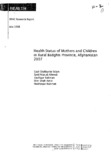| dc.contributor.author | Islam, Qazi Shafayetul | |
| dc.contributor.author | Ahmed, Syed Masud | |
| dc.contributor.author | Rahman, Taufiqur | |
| dc.contributor.author | Amin, Sher Shah | |
| dc.contributor.author | Rahman, Mashuqur | |
| dc.date.accessioned | 2019-11-28T04:01:10Z | |
| dc.date.available | 2019-11-28T04:01:10Z | |
| dc.date.issued | 2008-07 | |
| dc.identifier.citation | Islam, Q. S., Ahmed, S. M., Rahman, T., Amin, S. S., & Rahman, M. (2008, July). Health status of mothers and children in rural Badghis province, Afghanistan 2007. Research Reports (2008): Health Studies, Vol - XL, 18–42. | en_US |
| dc.identifier.uri | http://hdl.handle.net/10361/13144 | |
| dc.description.abstract | To assess the impact of BRAC health programme on sanitation. antenatal care. delivery
practices, contraception, breast-feeding. immunization. and childhood illnesses in Badghis
province during 2004-2007. This cross-sectional survey used a random sample of households
(n=450). The respondents were all married women of reproductive age ( 15-49 years) and
under-five children of the sampled households. Since no baseline information was available,
the findings were compared with the provincial estimates for Badghis province ti·om the
Multiple Indicator Cluster Survey 2003 (MICS) and in some cases with estimates from a
similar study carried out by BRAC in Balkh province in 2006. Nearly 75% of the adult
population had never been to school. The mean age at marriage for girls was i 6 years in 2007.
Safe sanitary practices increased marginally (20% to 27%). Awareness of the danger signs of
pregnancy complications (32'Xl). provisions of immunization against tetanus (48%) and
antenatal check-up during pregnancy (44%) have not improved among women compared to
what was found in Balkh province (45'Yo, 59% and 49% respectively) in 2006. The delivery
under the supervision of traditional birth attendant increased I 0% (MICS 2003) to 83%,
while the use of post-natal care (PNC) remained poor (35%). The knowledge and practice of
family planning increased from baseline (MICS 2003) ( 16% to 56 .0%, and I% to 19%
respectively) in the last three years. There is marginal decrease in the proportion of breastfeeding
within 6-hr of delivery, from 79% at 2003 (MICS) to 72%. Bacillus Calmette-Guerin
(BCG) coverage of under-five children increased from baseline (MICS 2003) (21% to 84%)
but the coverage of measles remained somewhat unchanged at around 55%. However, vitamin
A coverage declined significantly during the study period. The prevalence of diarrhoea has
been remained high compared to baseline (MICS 2003) (around 50%) and the use ofORS has
increased. The awareness of mothers about the danger signs during a diarrhoeal episode of
children was higher (65%) compared to the Balkh study (50%). BRAC has achieved
development on some indicators. Attention needs to be given in areas like ANC, PNC,
management of diarrhoea and other childhood illnesses. | en_US |
| dc.language.iso | en | en_US |
| dc.publisher | BRAC Research and Evaluation Division (RED) | en_US |
| dc.subject | Health status | en_US |
| dc.subject | Mothers | en_US |
| dc.subject | Children | en_US |
| dc.subject | Badghis province | en_US |
| dc.subject | Afghanistan | en_US |
| dc.subject | BRAC | |
| dc.subject.lcsh | Child health services. | |
| dc.subject.lcsh | Maternal health services. | |
| dc.subject.lcsh | Community health services. | |
| dc.subject.lcsh | Public health--Afghanistan | |
| dc.title | Health status of mothers and children in rural Badghis province, Afghanistan 2007 | en_US |
| dc.type | Research report | en_US |

